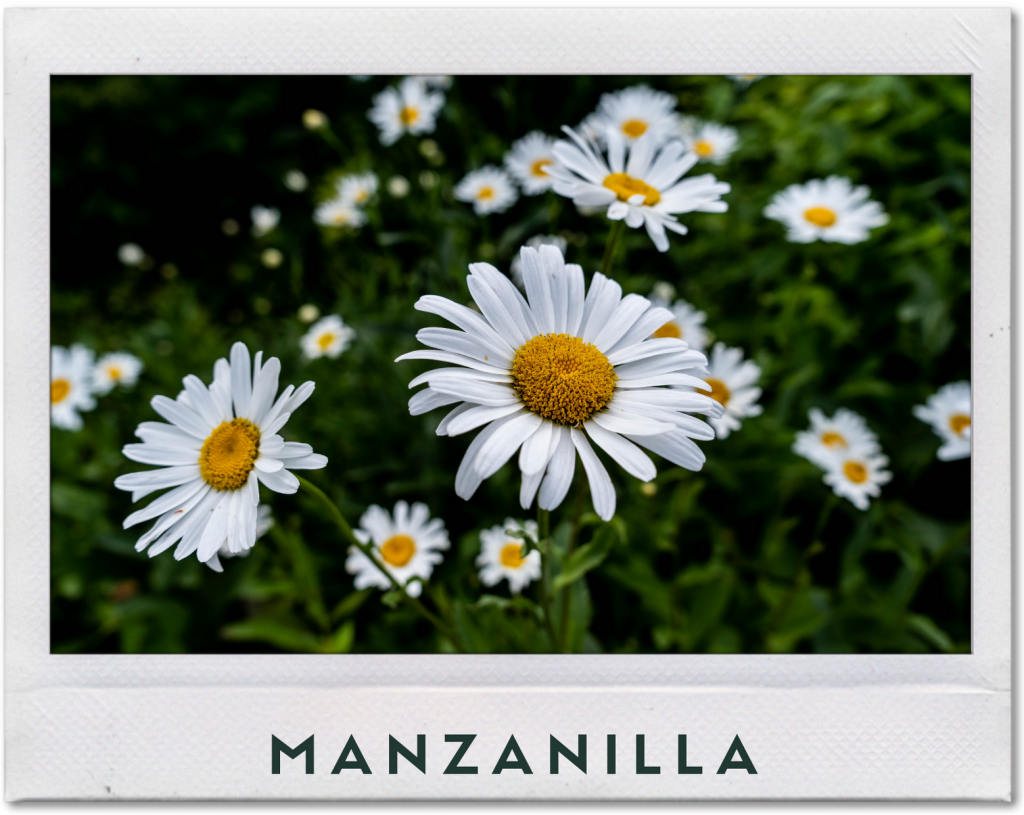Translated by Nick R
Would you like to grow a medicinal plant in your garden but don’t know which one? The Chamomile is a great option! Why? Well, it’s easy to grow, it’ll provide you with excellent and incredible healing properties, and it’ll also be helpful for your other plants.
So, if you want to learn about everything that chamomile has to offer and include it in your home, we invite you to continue reading this blog.
Below, we’re going to teach you everything about its benefits and the steps involved in keeping this plant at home. This way, you’ll be able to harvest with your own hands and also extract all its nutrients to enjoy them in your skin, hair, and body.
Table of Contents
Characteristics of chamomile
There are 2 types of Chamomile, the Roman (Chamaemelum Nobile) and the German chamomile (Matricaria recutita). Both plants have many similarities and therefore are sometimes confused, so what’s the difference between these varieties?
Roman Chamomile
The Roman variety is known as common chamomile and is usually the most cultivated type because it’s perennial, meaning it has a life span of more than 2 years. It reaches a height of 30 cm (12 in) and has hairy stems that produce a flower from its tip.
German Chamomile
The German chamomile, on the other hand, is an annual plant that easily self-sows and grows from 30 cm (12 in) to 1 m (3 ft.) high. A single stem gives rise to several branches that produce their own flowers.
Having said that, the German chamomile is characterized by its greater flower abundance, while the Roman, by creating the most fragrant ones.
Here is an illustration for you to see more clearly what we’ve just explained so that you can differentiate the 2 types of chamomile according to their shape and style of growth.

Regardless of which variety you choose to grow in your garden or vegetable garden, both herbs are suitable for human (not animal) consumption, thus they’re widely used due to their medicinal properties. They are even great for repelling pests and attracting pollinators.
Methods to extract chamomile nutrients
How to extract chamomile nutrients by infusion?
You’ll need warm water, preferably just boiled but no longer on the stove. Then, add several dried chamomile flowers, stir a little and let it stand for at least 15 minutes.
Keep in mind that the volume of water depends on how much you want to prepare. That is, if you’re going to make one or several cups of tea for immediate consumption, or if you’re going to make a tonic to use for several days on your skin or hair.
Likewise, use 2 or 3/4 teaspoons of flowers for each cup of tea, depending on the container in which you’ll store the tonic. Afterward, do not forget to strain the infusion to discard any plant residue.
In the case of the tonic, store it in an airtight glass or plastic container, however, we suggest a diffuser or atomizer to make applying easier. It can last for more than 1 week, as long as it preserves its natural scent and color.
How to extract chamomile nutrients by oil?
Besides the dried chamomile flowers, use a carrier oil of your preference. For example, it could be olive oil, coconut oil, almond oil, argan oil, etc. Or even 2 of them combined.
Then, place ¾ of the flowers in an airtight container and add the oil until filling the bottle. Cover the container tightly and leave it in a warm place for 4 weeks, at least, without direct sunlight. Also, shake the container from time to time to mix the product.
After this time, use filter paper or a cloth strainer to separate the oil from the flower remains to make it more pleasant to use.
How to take advantage of chamomile nutrients in shampoo, conditioner or creams?
For this method, use the oil we just taught you to prepare and add a few drops to your body and hair care products, for example, in your shampoo, conditioner, mask, styling cream, body creams, and others.
The larger the container, the more drops of oil you add and the more you need to stir. Later, we’ll recommend some homemade masks that you can make with chamomile that you’ll surely love.
Medicinal uses of chamomile
To continue, we want to talk about all the benefits that chamomile brings to our body and tell you how and how often to apply it or consume it.
Benefits of chamomile on the skin
If you use chamomile on your skin it’ll help you to:
- Soothe irritations: It has anti-inflammatory properties that are perfect for sensitive skin that has suffered an allergic reaction or to treat irritations such as eczema and other dermatitis problems. That being said, it acts as a de-inflammatory and reduces skin redness.
- Lighten blemishes: As you may know, chamomile is well known for its lightening effects on hair, although, is also helpful in improving the aspect of blemishes on the skin, including dark circles under the eyes.
- Diminish acne: This is because it cleanses deeply, and as it is antibacterial, it eliminates skin impurities. This way, it controls oiliness, closes open pores, and thus fights acne and rosacea with its antiseptic properties.
- Moisturize and revitalize: Apply chamomile in tonic or combine it with your body cream; it’ll serve you to get a softer and hydrated skin. Also, besides refreshing, chamomile promotes cell regeneration thanks to its phytochemical and polyphenol compounds.
So, to use chamomile on your skin, simply spray the toner using a diffuser or a spray bottle. It can be done routinely once in the morning and once in the evening or whenever you feel like freshening up.
Similarly, you can soak large pieces of absorbent cotton in the toner, and then place them on your skin focusing on blemishes or dark circles and leave them on for 15 minutes or more. No need to rinse.
On the other hand, you may also use the oil directly in those areas affected by dryness or any redness caused by sunburn or eczema. You can also combine it with your facial or body cream products for extra nutrients.
Additionally, we want to teach you how to prepare this chamomile, oatmeal, and honey mask. The ingredients are:
- 1 cup of cold chamomile tea
- 2 tablespoons of oatmeal
- 1 teaspoon of honey
All you need is to mix all the ingredients until you get a uniform paste and then spread it all over your face using your hands or a brush. Leave it on for 20 to 30 minutes, and then rinse with warm water.
Do this process 1 or 2 times a week to brighten your complexion and make it softer and more moisturized. Plus, the best part is that it’s perfect for all skin types.
Benefits of chamomile on hair
Implementing chamomile into your hair care and shampooing routine will help to:
- Nourish the scalp: chamomile nourishes and stimulates the hair follicles to bring greater vigor and strength to the hair. Thanks to this, it prevents split ends or dry and brittle hair.
- Shine: In addition to providing nourishment, it also gives a beautiful natural shine that is characteristic of healthy, soft, and strong hair.
- Naturally lightened hair: Surely this is the best known of the benefits that chamomile gives to hair and is thanks to its contribution to hair products and to the testimony of those who have tried it. For this, what really counts is regular use and some tips that we’ll give you below for lightening your hair by 1 or 2 shades.
- Combat dandruff: Chamomile helps in the scalp desquamation, leaving the scalp clean and free of dandruff. It also relieves itching and soothes irritation.
To use chamomile tonic on your hair, you can apply it with a spray bottle and use it after showering when your hair is damp. If you want to take advantage of its lightning benefits, we suggest letting your hair dry naturally in the sun.
For nourishing and fighting dandruff, it’s essential to use the chamomile and oil oleate that we teach you to make. It should be applied to the entire scalp by massaging with your fingertips and then spreading it all the way to the ends.
The longer you leave it on, the better. So we advise you to use it overnight and wash your hair, as usual, the next day.
Now, take notes on how to prepare this chamomile mask with honey. Likewise, we invite you to visit our blog about hair care plants. There you’ll find another helpful chamomile mask.
That said, you only need to mix thoroughly, 1 cup of chamomile tea and 1 tablespoon of honey. Then, put this treatment in a spray bottle and spread it all over your hair. Then, leave it in the sun for a while and wash it off with shampoo.
Benefits of chamomile in the organism
Drinking chamomile tea is perfect for:
- Reduce anxiety or stress: this plant will help you restore calm and enter a state of relaxation. So drinking a cup of chamomile tea will be helpful due to its calming properties and sedative effects.
- Fall asleep: Given the previous benefit, chamomile will help you to release tension and thus you’ll be able to fall asleep more quickly. Moreover, it will have a better quality thanks to the apigenin; an antioxidant that reduces insomnia.
- Improve digestion: It’s excellent to combat stomach discomfort, reducing intestinal irritation and avoiding nausea and gas. It also relieves the sensation of heaviness and fullness.
- Relieve menstrual cramps: That’s right! If you suffer from severe cramps, try drinking a cup of this natural remedy. Its anti-inflammatory and analgesic properties will help you with premenstrual symptoms and when passing through this cycle.
- Control blood sugar: It’s also ideal for those who suffer from diabetes as it helps control the glycemic index.
To prepare chamomile tea you only have to follow the same steps we gave you to make an infusion. If you wish, you can add a little honey to give it a natural sweetness. Also, you can include other aromatic and medicinal plants to get more benefits and flavor, such as mint with which it complements very well.
You can drink a cup of tea per day and several times a week whenever you feel it is necessary.
Benefits of chamomile in the vegetable garden
As we had told you briefly in the introduction, planting chamomile in your vegetable garden will also be beneficial for your other plants. This because:
- It attracts beneficial insects such as pollinators.
- It repels and fights pests since it acts as a natural insecticide. In particular, it removes whiteflies and red spider mites.
- It activates the soil and compost microorganisms. These are of utmost importance as they transform organic matter faster to make it edible for the roots.
So, apart from planting chamomile along with your other plants, especially those that produce fruit and are often vulnerable such as tomatoes, you can also use its infusion for irrigation.
So, you can mix equal parts of water and chamomile tea and apply them to your plants to enjoy the last benefits mentioned above.
Steps to grow chamomile in your vegetable garden
Now we’re going to explain how to plant a chamomile in your vegetable garden and how to take care of it.
Reproduction of chamomile
Chamomile is propagated by seeds mainly because they’re easy to obtain and germinate. Therefore, it’s rarely propagated by cuttings as this is not the most recommended method.
That said, you can buy the chamomile seed sachets in nurseries or garden stores or collect them from plants you already have for reseeding. Later we’ll tell you how to do so.
But, we have another alternative for you. Every sachet of chamomile tea that you buy in the supermarket, includes a lot of seeds. Thus, it’s an excellent alternative.
Chamomile sowing process
You can start the sowing in a seedbed or directly where you’ll have your chamomile crop. Likewise, if you are in a warm area, you can plant it at any time. However, if temperatures are too low or winter is just around the corner, it’s advisable to start the process indoors or wait at least 1 week after the last frost.
For sowing in pots, seedbeds, or gardens, what you should do is spread several seeds all over the surface. Likewise, with teabags, just open them and spread their content on the soil.
Afterward, add a thin substrate layer on top without pressing, and water deeply with an atomizer or a watering can. This is very important because if you cover the seeds with a lot of soil, they’ll have a harder time germinating. That said, after 15 days, you should notice small growing plantlets.
Now, in case you started sowing indoors and need to transplant to the definitive place, the ideal time is when the plants are more or less 5 cm high.
Care of chamomile

Container: You can grow chamomile in pots, beds, or directly in the ground. When choosing the first option, simply make sure that they have appropriate drainage holes to avoid waterlogging.
On the other hand, in the last 2 cases, you can opt for mulch to help water drain better and maintain humidity.
Soil: Chamomile likes nutrient-rich soil, as it will strengthen its stems and benefit flowering. Additionally, it’s best that the soil has good aeration and is not too compact, especially during the germination of the seed.
For this reason, we recommend using loamy soil, which is good for maintaining humidity but doesn’t waterlog. You may also supplement with compost to nourish the plants best.
When it comes to pH, chamomile prefers a neutral one, which would range between 6.5 and 7.5.
Watering: Actually, chamomile is not demanding about water, and it’s even considered tolerant to drought. However, regular watering helps it bloom for longer, although chamomile can be very hardy once it is well established.
So, allowing the soil surface to dry out between waterings is best, but be mindful of the climatic conditions of the area where it is planted. In much warmer climates, it’ll need frequent watering.
Climate: Chamomile likes either direct sun or partial shade. Again, this factor will help in flowering and would also be crucial during seed germination.
Pests: As mentioned, chamomile is often used as a companion plant: its scent often keeps non-beneficial insects away. However, if the plant is weak, it can be attacked by pests such as aphids and mealybugs.
In case this happens to you, don’t worry! You can use a homemade insecticide or the unmatched one for combating pests, neem oil, and potassium soap.
As for temperature, it can thrive in heavy summer climates that reach up to 37° C. But, in general, it prefers a moderate temperature range of around 20 to 25°C.
Harvest of chamomille
Chamomile typically produces flowers within 6 to 8 weeks after seed germination.
Try to harvest the flowers once they are fully open or when the petals have begun to curl downward. The leaves tend to be bitter, so don’t pick them.
To do this, you’ll need a pair of pruning shears and cut small branches with flowers sprouted right at the node, which is where they join the main stem. This will also serve to encourage more flowering.
Then, commonly, the flower heads are left to dry in a cool place for at least 1 week. Although it’s said that they can also be used fresh, to prepare a cup of tea you should double the number of flowers.
Final recommendations
Remember, enough is as good as a feast, which is also true for consuming any plant orally. Excessive consumption of Chamomile can have a sedative effect and cause nausea or vomiting.
If you’re under medication, it’s better to consult your doctor before adding chamomile tea to your routine. Likewise, pregnant or nursing women should take extra caution.
Finally, we hope this blog has been of great use to you and that you’ve learned all the benefits that chamomile has to offer. So, we encourage you to put all the tips we gave you into practice and that you dare to grow your own chamomile plant at home.


